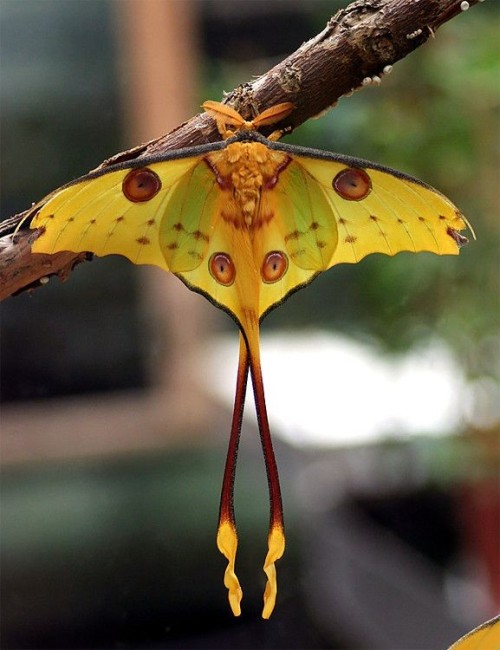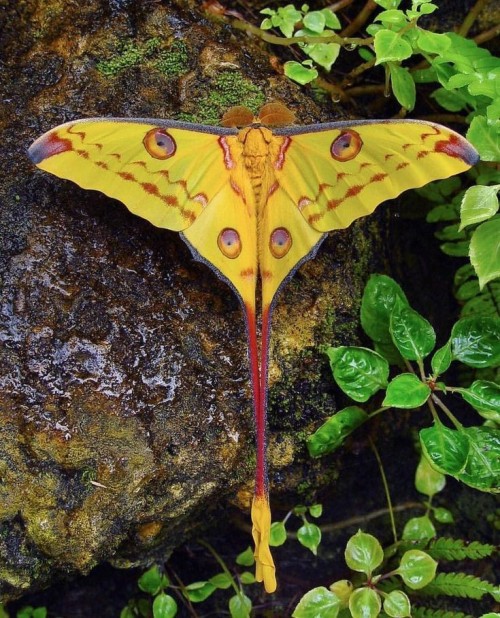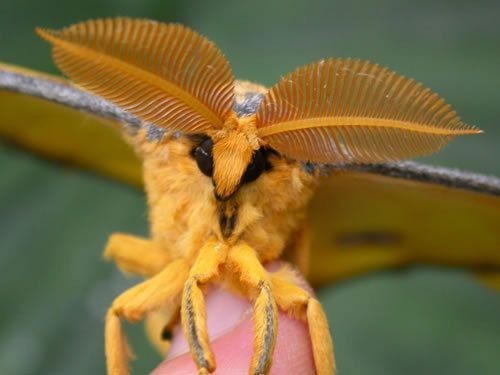Comet Moth - Tumblr Posts
Moth of the Week
Comet Moth
Argema mittrei
TW: Trypophobia for pictures

The comet moth or the Madagascan moon moth was first described in 1847 by Félix Édouard Guérin-Méneville. This moth is a part of the Saturniidae family and is one of the largest silk moths. This species receives its genus name Argema, meaning 'speckled eye' in Greek, from the large eyespots on its forewings and hindwings. Additionally, the name comet moth comes from their long hindwing tails.
Description The comet moth has large yellow wings with magenta patterns by the head, at the tips and outer margin of the forewings, the top and bottom of the hindwings, and the stem of the hindwing tails. Furthermore, the top edge of the forewings, outer edge of the hindwings, and both sides of the tail are outlined in black. Each of the hindwings and the forewings have large magenta and orange eyespots also outlined in black. The final touch on the wings are white accents by the head and in the eyespots. The body of the comet moth is yellow or a yellow-orange with the top of the legs matching then fading to black. They also have orange antennae.
Females have more rounded wings and larger bodies for egg laying
Average male wingspan: 20 cm (≈7.9 in)
Average male tail span of 15 cm (≈5.9 in)
The males have a longer, more feathery antennas than the females to pick up mating pheromones
Males have longer, thinner tails while females have shorter, thicker ones
Diet and Habitat This moth’s diet and host plants include the smoke tree, the marula tree, the Brazilian peppertree, and the cider gum tree. Most sources say adult moths do not feed because of their inability to use their shrunken mouths. Comet moths are native to Madagascar and nowhere else in the world. Their natural habitat are the Madagascan rainforests. However, they can and have been bred in captivity. Today due to habitat loss, their range is limited to the rainforests located south and east of Madagascar’s capital.
Mating Female moths release and pheromone to attract male mates, who fly to find them. After mating, the females lay 120 to 170 eggs on the host plants that will hatch into caterpillars in 10 to 20 days.
Predators Chameleons, geckos, bats, and birds prey on comet moths. To combat this, the comet moth uses its colors to camouflage itself. Additionally, it uses its long tails to mess with a bat’s echolocation and cause it to attack the tails instead of the moth’s vulnerable body. Furthermore, this species has the ability to use ultrasound absorption so the bat’s echo will come back fainter, and the moth is harder to “see.”Finally, the wing’s eyespots are used to fool predators into thinking the comet moth is a more dangerous animal. The largest current threat to comet moths are humans, and this moth is now endangered sure to habitat loss.
Fun Fact This moth used to be on the 1000 Malagasy ariary banknote.
(Source: Wikipedia, AZ Animals, Natural History Museum UK, The Company of Biologists, Moth Identification)







The comet moth or Madagascan moon moth (Argema mittrei) is a moth native to the rain forests of Madagascar. The species was first described by Félix Édouard Guérin-Méneville in 1847. The adult moth cannot feed and only lives for 4 to 5 days. Although endangered in the wild due to habitat loss, the comet moth has been bred in captivity.
There are physical differences among females and males. Females have more rounded wings. The male has a wingspan of 20 cm (7.9 inches) and a tail span of 15 cm (5.9 inches), making it one of the world's largest silk moths. The males have long, feathery antennas and the females have thin antennas. Argema mittrei wings have large eyespot, giving the appearance of a large and dangerous creature that should not be attacked.
